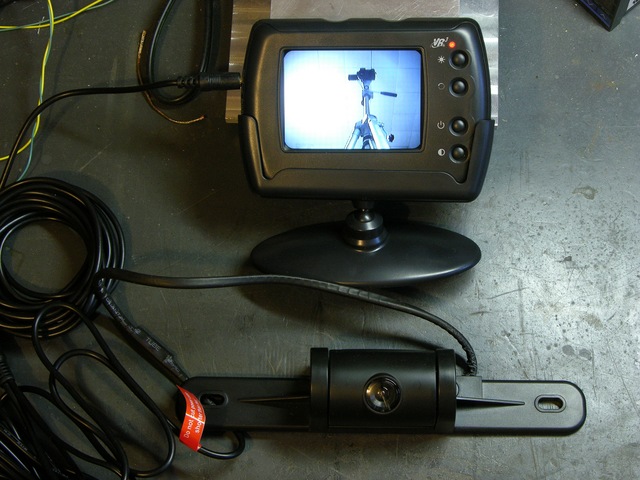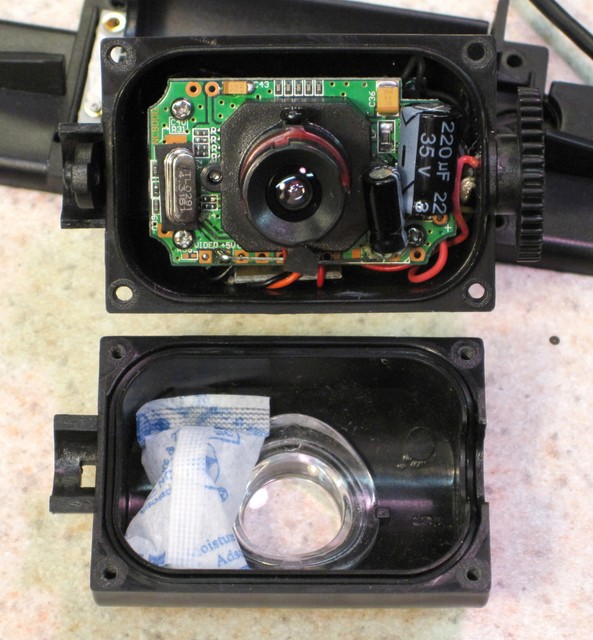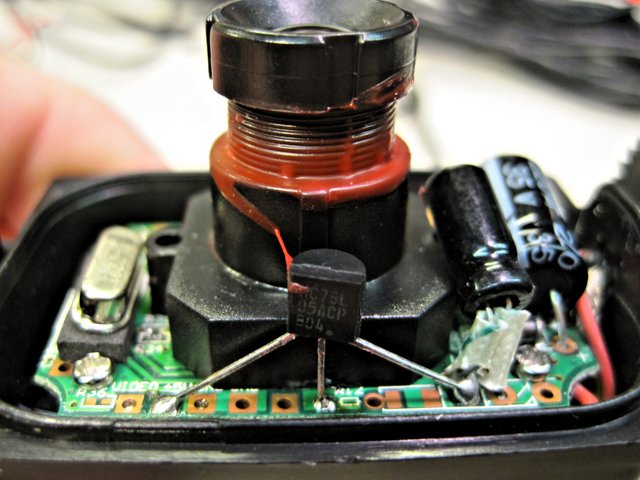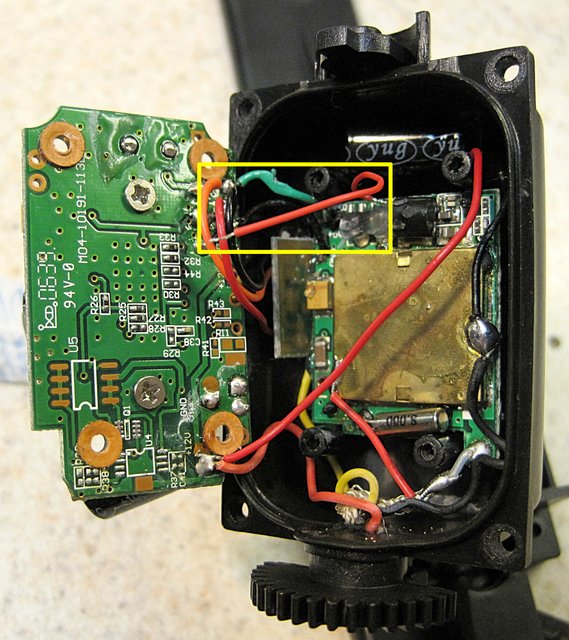After backing my bus into my neighbor’s mailbox, I ordered a backup camera from Amazon. The camera touts wired and wireless operation, and I already knew I’d want to use the wired connection for best picture quality.
Since the Amazon product description for the related VR3 backup camera with 2.5″ LCD says the wireless connection is 2.4GHz and that’s the same frequency band as 802.11b/g, I also knew I’d want to be sure the wireless transmission was inactive so it didn’t interfere with wi-fi reception in the bus. The support document says:
Some of our cameras have the ability to be hardwired to the monitor. This will eliminate interference by completely shutting down the wireless reception.
Which sounded pretty good. All you need is their $20 extension cable … well, no. Their cable is only 25′, and I’ll need about 50′ to get from the back of the bus to the front. Plus I don’t feel like paying $20 each for cables I’d have to chain together when I can just as well build a cable customized to my own liking.
Testing Wired Operation
I was visiting Cort in July anyway, so I took my new camera along for him to help me try out wiring it up and disabling the wireless transmission. As an avid amateur radio operator and repeater maintainer, he’s even better equipped for this than I, and his spectrum analyzer sure came in handy.
We started by powering up the camera and display on the workbench using their default wireless transmission. They worked, but the picture was fairly noisy, even a few feet apart, pretty much as I expected.
Next we wired them together. At least one picture of the $20 cable appears to have 1/8″ tip-ring-ring-shield connections to deliver both power and video, so Cort pulled out some iPod RCA breakout cables to use with gator wires in the middle to hook things up.
Naturally he was metering and scoping the pins before just plugging it in and letting it work; and interestingly enough, as I recall, the plugs’ shield connection wasn’t connected. As far as we could tell, the system shares ground between power and video and perhaps wraps the whole thing inside a nonconnected braided shield; but at any rate only uses three live wires from end to end. For convenience of cables Cort had on hand without having to jumper things in the middle, we switched to a 1/8″ male-male TRS cable and it worked just fine. And coincidentally, another picture I found later of the same commercial extension cable only looked like tip-ring-shield as well.
“Worked just fine” means that the image quality improved dramatically, as in the picture above. However, it doesn’t mean that the wireless transmission stopped. Cort was astounded (and commenting repeatedly during the half hour we were playing with it) on the incredible amount of broadband noise this thing puts out. I’m really surprised it was able to get FCC Type 15 certification, based on what I saw on Cort’s spectrum analyzer. Massive spikes at 480MHz and 960MHz (which doesn’t even make sense) and background noise all over the place, all of which came and went with application of power to the camera.
Rereading the support information, wiring the camera to the display shuts down interference to the display by eliminating wireless reception. Obviously I wanted to eliminate wireless transmission, so we were going to have to go a little further.
Time for Surgery, Doctor!
We opened the camera to figure out how to disable the radio transmitter.
The first thing we found was the camera’s weatherproofing. How clever.
The gear on the right is for the “clicky” tilt positioning of the camera, by the way. It’s not a remote pan/tilt.
Cort was enthralled with the mounting of the voltage regulator. I admit it’s kind of cute.
At this point Cort was just doing and not really talking or showing, so I was following along as well as I could from four feet away. The crux of the matter, if I understood correctly, was that the video signal from the camera routed electrically through the transmitter before leaving the camera, so it wasn’t clear whether disabling the transmitter would break wired video as well (which would mean trying to reroute the feed around the transmitter and hoping there wasn’t any level-shifting going on in the transmitter that was needed for the wired output).
Cort lifted the power wire to the transmitter and the RF noise (and wireless image) immediately disappeared. We retested wired image transmission and it was still there and in good condition; so happily, killing power to the transmitter was a pretty easy fix for the problem.
We left the power wire inside and attached at the transmitter end so it could be reconnected easily if anyone cared in the future, but isolated so it wouldn’t short anything out. I would have put heatshrink over the end, but I think Cort just layered it with electrical tape, which will get nice and gummy inside the black camera body in direct sunlight in August in Kansas.
Installation Plans
Everything’s back together and working great. Cort suggesting using 75Ω coax to get the (non-RF-modulated) video signal from the back of the bus to the front, and I think I’ll run a separate power line to the camera. Because I’d like to be able to share the camera image with more than just my little LCD at the front, I think I’ll install a three-way toggle switch for power — off, on, camera-only. I’d also like to find a 15″ or larger LCD monitor with video input that I could use instead of the little LCD for a much better image — if anyone has an old one sitting around that they’d like to throw my way, please let me know.
Ultimately I’d like to supplement the backup camera with two “passing” cameras, about 2/3 of the way back on each side of the bus, to help confirm that the road is clear all the way to the back of the bus for lane changes. (Even after I get used to passing using only the front mirrors, I expect I won’t be the only driver on long trips and I’d like the bus to be as safe and easy to drive as possible.) I’d love to find a picture-in-picture video switcher to put the three small rear-view images across the bottom of a larger LCD and choose one to display full-size on the main part of the screen.
Ultimately ultimately I’d like all of the cameras to be network cams tied into the bus’s communications and video computer system, with views available to anyone in the bus and available to record on demand. But that’s a story for another day.




There are a lot of cheap quad splitters for sale on ebay that will also do 2 small images ontop of one large one, and a split view with half of 2 images shown side by side which would probably be along the lines of what you want. Also have support for mirroring cameras incase you get some that dont have the mirroring done internally.
Richard, thanks for the tip! I’m not finding those, but I’m probably not searching for the right keyword. Could you point me to one to get me started?
Are you using this with backup light connection or wired separately to turn on whenever you want…..without wireless does it stay on constantly or gets cut off after few minutes and back on?….the reason I am trying to find out is I am wanting to use this VR3 camera on my motorcycle as my rear view camera so I can see how close vehicles are behind me. I have it connected directly using their extension cable but I am still getting cut off constantly.
Thanks!
Dragon, I don’t plan to use it with the backup lights and so far I’ve only used it on my workbench, where it works very reliably for as long as I’ve cared to leave it connected. If yours is switching on and off and you’re running it directly from the motorcycle battery, I’d strongly suspect something in the wiring.
If it’s easy to unmount, take it off the bike and put it on your table with a 12V power supply (or motorcycle battery) and see how well it works there. Might be easier to debug than on the bike.
By the way, I love the idea of putting this on a motorcycle! I hadn’t thought of that and it seems like it could be a great supplement to the side mirrors.
Keith, I don’t have it spliced into my motorcycle wiring, instead I am using cigarette lighter as power source, just like my truck cigarette lighter power source and I have extension cable running directly to the camera to the rear of my bike. I now have it mounted on my truck but without extension cable and still has interference like it was on my bike…..maybe I should not say cutting in/out, instead wireless interference.
I wonder if I follow what you have stated “Cort lifted the power wire to the transmitter and the RF noise (and wireless image) immediately disappeared. We retested wired image transmission and it was still there and in good condition; so happily, killing power to the transmitter was a pretty easy fix for the problem.” will help with this interference….any idea?
Can I ask you to capture a short video clip of your setup and email to me or the link of it? karsung@yahoo.com
Thanks!
Keith, I mounted my camera to my truck and I am still getting that wireless signal cutting in & out…does your do that before you disabled wireless part? I wonder if I have a defective unit? I was seeing that with straight cable from monitor to the camera…..any idea????
Thanks!
Steve, I’m not following exactly what you’re doing. If you’re using the cable from the monitor to the camera, the monitor’s wireless reception is disabled and there’s no way the monitor can receive wireless interference. In that circumstance if you’re seeing an intermittently bad picture, it’s a different problem — possibly noisy power (add an LC filter to the power feed) or a bad unit.
What Cort and I did was disable wireless transmission by the camera, not to have anything to do with the image quality (because I was already planning to use a wired connection for that) but to prevent the camera from sending a wireless signal that would interfere with other (unrelated) devices in the area.
Does that help?
Keith, sorry for the confusion….what I am trying to do is using the camera the way it came from the manufacturer using wireless however the interference is too much where its cutting in & out…..so I tried using straight cable on my motorcycle and still having the same issue….not sure if I have a bad unit or noise issue as you’d stated……before I start disabling wireless feature I will go get another unit to see if the issue is the unit itself or interference with wireless……
Any suggestion is welcome at this point…thanks!
Steve
Steve, if you’re using wireless and getting bad reception, I’m not surprised.
If you’re using the cable and you have a bad signal, it has nothing to do with the wireless and there’s nothing you need to disable — it’s a bad unit. There’s no interference happening with the cable because there’s nothing to interfere with; the wireless reception is disabled.
Keith, thanks for all your answers…..I will get another unit to test and if the issue is the unit then I will get it replaced….appreciate all your help with this.
Steve
Great post, Keith!
I have one of these units, but it is an older one, and is only wireless. It does not have the option of plugging in an extension wire.
Any idea how to get the video signal out of the camera and into the monitor with a wire instead of wireless? I’ve opened up both camera and monitor, but it’s not clear to me how to acquire the signal.
Thanks!
Lee
Lee, there’s no guarantee that the signal is available in usable form, BUT if it’s going to be, it’ll be on a wire going from the camera PCB to the wireless PCB. (I assume they’re separate boards in yours too.) I’d poke around with a scope to find a wire with what looks like a video signal on it — of course, not everyone has a scope.
Thanks for the reply, Keith. Sadly, I don’t have a scope, and although I’m pretty handy at fixing electronics, once it gets too complicated, I’m out of luck. I’ll look for the wire. The inside of my camera looks almost identical to yours (just a difference in caps). Can you tell me where that wire is on yours?
Thanks so much!
PS – I waited on hold with Roadmaster to ask them about this, and after 45 minutes I gave up, and just left a message. Have not heard back from them.
Lee, without opening mine back up (which I really don’t care to do), the best I can do is look at the picture I took.
I’d say you can fairly easily figure out which wires are power and ground (check continuity with the power connector and/or hook up power and check with a voltmeter). I think you can also rule out any connections that have multiple wires going the same solder blob. I’m guessing you won’t have much left; and you can try feeding that to a composite video input and see what happens.
OK Keith, I’ll give that a try when I have a chance in the next few weeks. I assume I can do the same thing on the receiver end, look for a single wire connecting the wireless PCB to the monitor PCB? (Assuming there are two PCB’s, I haven’t looked recently)
Thanks!
I found the video output on the camera. It was actually labeled “video,” so that was pretty easy! It’s a usable signal, I feed it into my portable DVD player and got a picture.
What I can’t figure out is how to input it into the monitor PCB.
If you have a chance, could you look at the pics and see if anything looks like it could be a video input? I’m guessing this board is pretty much the same as yours, since the cameras are practically identical.
Thanks for all your help!
http://s793.photobucket.com/albums/yy212/sciencemagic/?action=view¤t=SANY0466.jpg
http://s793.photobucket.com/albums/yy212/sciencemagic/?action=view¤t=SANY0462.jpg
http://s793.photobucket.com/albums/yy212/sciencemagic/?action=view¤t=SANY0463.jpg
Lee, nothing leaps out at me, but I have a few ideas and remarks.
Hey Keith!
Thanks for looking over my pictures. I appreciate your insight. Not long after I made that last post, I was playing around with the signal from the camera, and shorted something I wasn’t supposed to. I think my camera uses IC’s as voltage regulators, as there are two IC’s where your board is blank, and I don’t have that VR sticking up like you do. Anyway, the picture disappeared, and the 5V on the board disappeared as well. So I think that camera is basically shot.
Fortunately it was a spare, and I still have the old camera on the van, so I can still use it, albeit only wirelessly.
After destroying the camera, I decided not to push my luck, and sealed up the monitor, then went to eBay to look for a wired version. I may still use the wireless cam on my little van, where distance is not a problem.
Thanks again for your help!
Lee
Keith… I have a few of the VR3 monitors that I am playing around with and trying to hardwire an alternate brand of camera using a camcorder 1/8″ cable which has the 4 piece tip-ring-ring-shield like you friend used but that was an i-pod cable.
Could you please tell me what each section of the tip-ring-ring-shield is transmitting? I’m looking to find out which is the +, the ground (which you also say is also the video ground) and which is the video single.
Thanks for your help…
T, I have no recollection. I’d be quite confident the shield is ground, and we found the rest in a matter of seconds by experimentation.
Thanks keith… I figured I would give you a try eventhoguh the last post was some time ago.
From what I read you are using a standard tip ring sheild to do the same thing instead of their tip ring ring sheild… If so I think I can figure it out from there… Thanks again for your help…
I have an older VR 3.5″ with the optional direct video input. I want to use it as a hardwired backup monitor.
It is necessary to use power in on the VIDEO/POWER input? Can I just have power in the POWER input and just use a composite signal to the video input?
I was going to use a 3/ring tip 3.5 mm connector with 3 RCAs so I would think one of those 3 should work.
I am not using the VR cam, a different one, and it is already wired to switch on with the back up lights on.
Ken, it’s been almost two years since I worked on this camera and I don’t remember every detail. What you suggest makes sense — what happens when you try it?
It was a shot in the dark when I ran into this discussion. I am picking up the appropriate cable this week. I was going to order up the proprietary cable from VR3 it’s 3mm to 3mm, designed to interface into their cam, but this should work the same and cheaper too.
I’ll report back when I try it. Thank for the reply, Keith.sg
Ken… Here is the write up I did on a forum I belong to…. The pics will help you. I bought the cheapest cable I could find on ebay…
http://www.ridgelineownersclub.com/forums/showthread.php?t=40061
This worked for both a 3.5″ and 2.5″ monitor version. The camera I am using is an audiovox.
It was my thought as long as you have power fed to the monitor (through either port) the video should work.
Based on your finding that does not seem to be true. I did take note of the stampings on the board inside, but then again, figured I did not need power into the video input connector if I had it elsewhere. But it is not working that way, so I will need to provide power through the other leads.
I am using a CCD from Boyo BTW. But it should not really matter.
I’ll try it and report back.
I thought the same thing about the power. I tried wiring up in that fashion but found using the voltmeter that the power wasn’t being transferred to the power/video input.
That’s makes total sense now. That’s how they are bypassing the RF transmitted video, by using a totally separate circuit for hardwired video.
OK.. got some modding to do to the cable to get this sucker working.
Will report back! thanks T!
BTW, found out a stereo cable would work just as well. The 3 rings will line up with the needed inputs. One RCA would be the video (tip), the other +12v (2nd ring) and the ground the base of the 3.5mm. Ground is common to both RCAs.
The one not used in the VR3 would not be affected. I will prove it out to be sure but this is what a quick continuity check says.
Yes you can use that type but it actually too tight. The only real risk I can think of is that extra pressure will weekend and may break the port of the pcm.
BTW Keith used a regular 3.5mm TRS. He mentioned using that instead…
“we switched to a 1/8″ male-male TRS cable and it worked just fine.”
Well, I got working both ways.
This works great, and thanks to all for your help. Glad a stumbled upon this blog. I will be checking back, noted some other interesting topics.
Congrats… Yeah there is nothing like having a hardwired camera.